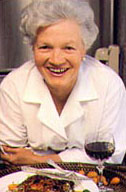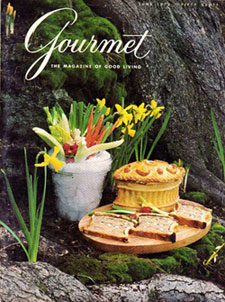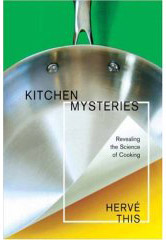Dear Madeleine,
 You probably don’t remember me, but as you read this it may all come back to you after the leagues of students that you have mentored pass by in a blur. You changed my life and I’m sure there is a long line behind me. The first time that I came to your cooking school in Newton Center, Massachusetts with Heidi Wortzel to introduce me, I was where I had always dreamed of being.
You probably don’t remember me, but as you read this it may all come back to you after the leagues of students that you have mentored pass by in a blur. You changed my life and I’m sure there is a long line behind me. The first time that I came to your cooking school in Newton Center, Massachusetts with Heidi Wortzel to introduce me, I was where I had always dreamed of being.
The smells on the outside of the entrance pale in comparison to how wonderful it smelled inside. Students were whirling around, busy making puff pastry and tending to their pots on the stove tops all with smiles on their faces. It was magical..I remember thinking you were so busy but so very welcoming as you talked about your school. The brick walls were covered with well-used, brightly-polished copper pots and oddly an upside down framed autograph from Paul Bocuse. It was where I wanted to be and I couldn’t wait to roll up my sleeves and learn all that I could.

 Call it denial having taken this long to write about it. Call it anything you want but there will be NO MORE Gourmet magazine in anyones mailbox ever again and that will take a lot of getting use to. It was always the first food magazine that I opened each month, the others could wait. Of course it's shocking and sad, the end of an era and no more Ruth piloting the ship. And I will most miss her.
Call it denial having taken this long to write about it. Call it anything you want but there will be NO MORE Gourmet magazine in anyones mailbox ever again and that will take a lot of getting use to. It was always the first food magazine that I opened each month, the others could wait. Of course it's shocking and sad, the end of an era and no more Ruth piloting the ship. And I will most miss her. There are times when I scrutinize my outfit before I leave the
house, and find it absurdly, compulsively over-accessorized. It’s
then, as I grab my keys and prance out with red sneakers, mismatched
bracelets, and a brooch shaped like a turnip, that I’ll find myself
thinking of her. Subtlety, in many things, is often advised; but I,
heeding Anne of Green Gables, rarely listen. If at a dinner party,
after I’ve gone on and on to someone about a book they’ll probably
never read, ignoring every attempt they make to escape me, she’ll just
appear in my mind. And often, when faced with a moral dilemma, like
whether to leave the last bite of pie for the person I’m sharing it
with, or to request that my upstairs neighbors stop rollerblading on
the hardwood floor, I’ll ask myself:
There are times when I scrutinize my outfit before I leave the
house, and find it absurdly, compulsively over-accessorized. It’s
then, as I grab my keys and prance out with red sneakers, mismatched
bracelets, and a brooch shaped like a turnip, that I’ll find myself
thinking of her. Subtlety, in many things, is often advised; but I,
heeding Anne of Green Gables, rarely listen. If at a dinner party,
after I’ve gone on and on to someone about a book they’ll probably
never read, ignoring every attempt they make to escape me, she’ll just
appear in my mind. And often, when faced with a moral dilemma, like
whether to leave the last bite of pie for the person I’m sharing it
with, or to request that my upstairs neighbors stop rollerblading on
the hardwood floor, I’ll ask myself:
 Eating alone is a trying thing for some people, writing cooking and eating off
as products of a banal bodily necessity. I love to eat and cook alone,
using the kitchen as an improvisational laboratory to experiment with
recipe ideas, flavor combinations, and cooking techniques. MFK Fisher,
a witty food writer with a fluid, deeply expressive writing style
bursting with gastronomic knowledge, shared my passion. She was one of
the best food writers out there, blurring the lines between the genres
of food anthropology, ecology, travel literature, and cooking.
Eating alone is a trying thing for some people, writing cooking and eating off
as products of a banal bodily necessity. I love to eat and cook alone,
using the kitchen as an improvisational laboratory to experiment with
recipe ideas, flavor combinations, and cooking techniques. MFK Fisher,
a witty food writer with a fluid, deeply expressive writing style
bursting with gastronomic knowledge, shared my passion. She was one of
the best food writers out there, blurring the lines between the genres
of food anthropology, ecology, travel literature, and cooking.


